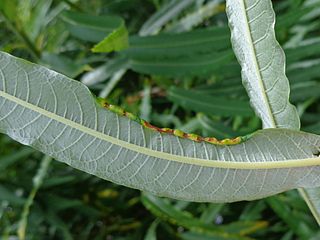
Salix nigra, the black willow, is a species of willow native to eastern North America, from New Brunswick and southern Ontario west to Minnesota, and south to northern Florida and Texas.

Rabdophaga rosaria is a gall midge which forms Camellia galls or terminal rosette gall on willow species. It was first described by Hermann Loew in 1850.
Rabdophaga clavifex is a gall midge which forms galls on the buds of willow species.
Rabdophaga repenticornua is a gall midge which forms galls on the buds of creeping willow.
Rabdophaga strobilina is a gall midge and inquiline of Rabdophaga rosaria and Rabdophaga terminalis; also gall midges. It was first described by Johann Jacob Bremi-Wolf in 1847.
Rabdophaga iteobia is a gall midge which forms galls on the buds of willow species.
Rabdophaga heterobia is a species of gall midges which has two generations a year and forms galls on almond willow. It was first described by Hermann Loew in 1850.
Rabdophaga jaapi is a species of gall midges which forms galls on creeping willow.

Rabdophaga rosariella is a species of gall midge which forms galls on sallows. It was first described by Jean-Jacques Kieffer in 1897.
Rabdophaga saliciperda is a species of gall midges which forms galls on willows. It was first described by Léon Jean Marie Dufour in 1841.

Rabdophaga salicis is a gall midge which forms galls on sallows. It was first described by Franz von Paula Schrank in 1803.
Rabdophaga degeerii is a gall midge which forms galls on the shoots of willows.
Rabdophaga albipennis is a gall midge which forms galls on the shoots of white willow.
Rabdophaga dubiosa is a gall midge which forms galls on the young shoots of willow.

Rabdophaga pierreana is a gall midge which forms galls on the young shoots of willow. It was first described by Jean-Jacques Kieffer in 1909.
Rabdophaga purpureaperda is a gall midge. The larvae tunnel in the shoots of purple willow and may cause the shoots to swell slightly. It was first described by Horace Francis Barnes in 1935.
Rabdophaga justini is a gall midge. It was first described by Horace Francis Barnes in 1935. The larvae tunnel in the shoots of purple willow.

Rabdophaga marginemtorquens is a gall midge which forms galls on willows and is found in Europe. It was described by Johann Jacob Bremi-Wolf in 1847.

Rabdophaga nervorum is a gall midge which forms galls on the leaves of sallows. It is found in Europe and was first described by the French entomologist, Jean-Jacques Kieffer in 1895.

Rabdophaga rigidae, the willow beaked-gall midge, is a species of gall midge in the family Cecidomyiidae. It is found across North America. Some sources state that it is also present in parts of eastern Asia including Japan; however, a 2006 study shows that the Asian populations likely represent a separate species: Rabdophaga salicivora.








